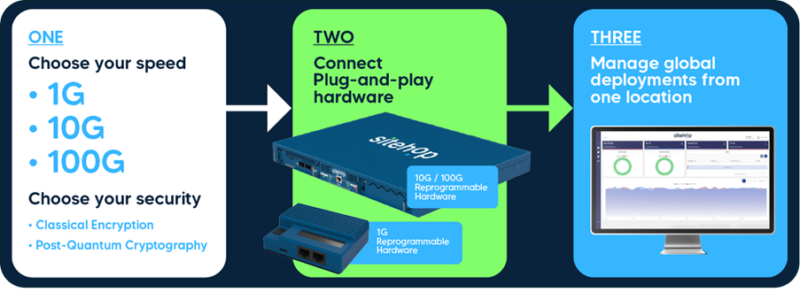
Introducing the SAFE Series Range Updates
April 25, 2025 | IPSec, Post Quantum Cryptography, Security
The world’s leading modular Hardware-Enforced Security for the future of enterprise encryption.
In a world where security and performance can no longer be trade-offs, Sitehop’s SAFE Series and SAFEcore deliver both—without compromise. Designed for organisations that demand ultra-low latency encryption at scale, this high-performance platform redefines secure aggregation for data centres, telecoms, and critical national infrastructure. Sitehop’s proprietary FPGA architecture enables real-time, crypto-agile security that keeps pace with today’s demands—and tomorrow’s threats. Discover more at www.sitehop.com
These new additions and upgrades to the SAFE Series range which, in addition to greater range flexibility, can enhance speed and security now and provide the foundations for being PQC ready in the future.
- New product: SAFEencrypt 10G
- New Product: SAFEpqc 100G
- New product: SAFEpqc 10G
- New features: Sitehop SAFEnms™
The SAFE Series can be ready for on-site installation in minutes:

So why does this matter? Because as global cyber threats grow in sophistication, enterprises, telcos, and governments need encryption that doesn’t just keep pace but stays ahead. Traditional software-based encryption introduces latency, inefficiencies, and vulnerabilities—creating bottlenecks where security should be seamless.
The Sitehop SAFE Series changes everything. This modular, high-performance hardware encryption system delivers unmatched security for data-in-motion—ensuring ultra-low latency, crypto agility, and future-proofed PQC readiness.
Why SAFE Series? Addressing Key Industry Challenges.
Organizations today face mounting challenges:
- Performance Bottlenecks: Software-based encryption slows down networks, increasing latency in mission-critical operations.
- Post-Quantum Readiness: With quantum threats on the horizon, businesses need encryption that can seamlessly transition to PQC.
- Scalability & Availability: Mission-critical systems demand high-throughput encryption without downtime or performance trade-offs.
- Operational Complexity: Managing encryption at scale is challenging without centralized control and automation.
- Energy Consumption & Sustainability: Power-hungry encryption drives up costs and environmental impact.
The SAFE Series directly addresses these pain points—delivering an advanced encryption framework that protects today while preparing for tomorrow.
SAFE Series. Engineered for Now. Built for the Future.
The SAFE Series is designed to optimize security without compromising performance.
- Sub-Microsecond Latency– Secure real-time data with deterministic, ultra-fast encryption.

- End-to-End IPsec Security– Protects sensitive data across multi-domain networks without performance loss.
- Crypto Agility & PQC Readiness– Seamlessly upgrade cryptography as new standards emerge.
- Energy Efficient– Uses up to 10x less power than software-based encryption solutions.
- Scalability & High Availability– Modular system design allows hot-swappable upgrades for future expansion.
Simplified Encryption Management with Sitehop SAFEnms™
Managing encrypted networks at scale requires visibility, automation, and control. The Sitehop SAFEnms™ (Network Management System) delivers:
- Advanced Monitoring & Auditing: Real-time network insights for optimal performance.
- Role-Based Access Control (RBAC): Secure, multi-tenant user management for large deployments.
- Built-In PKI & Certificate Management: Simplifies cryptographic administration.
- REST API Integration: Seamless connection with existing management systems.
With the Sitehop SAFEnms™, organizations can streamline encryption management—ensuring effortless deployment, monitoring, and security policy enforcement across global networks.
A New Era of Secure Networking Starts Now
The SAFE Series isn’t just another encryption product—it’s a transformational shift in how networks are secured.
- Hardware-enforced, ultra-fast encryption for mission-critical networks.
- Seamless migration to PQC-ready security without costly upgrades.
- Scalable, high-availability encryption that integrates with modern network architectures.
Future-proof your encryption, maximize performance, and stay ahead of tomorrow’s cyber threats—today.
Talk to us about deploying the SAFE Series in your network today.
Sitehop. Engineered for speed. Built for the future.
Call us on: +44 (0)114 478 2366
Or email info@sitehop.com

The New IPsec Strategy: How Sitehop Solves the Challenges and Makes IPsec the Future of Secure Networking
April 7, 2025 | IPSec, Security
Introduction: The Shift Back to IPsec
For years, organizations moved away from IPsec due to concerns over performance, complexity, and scalability. In its place, MACsec became the preferred option for securing Ethernet links, offering a simpler approach to encryption. But as networks expand beyond traditional boundaries—spanning cloud environments, hybrid infrastructures, and multi-domain ecosystems—MACsec’s limitations are becoming increasingly clear.
Now, with Sitehop’s ultra-low-latency, hardware-accelerated IPsec, the equation has changed. The challenges that once made MACsec the default choice are no longer relevant. IPsec is back—stronger, faster, and more adaptable than ever before. This isn’t just about encryption; it’s about building a future-proof strategy for secure networking.
So, why is IPsec the right move now? Let’s break it down.
1. True End-to-End Security Across Domains (Multi-Hop Protection)
One of the biggest limitations of MACsec is that it only works within a single Layer 2 segment. Once data leaves that segment—crossing routers, service provider networks, or cloud environments—MACsec encryption is lost. This creates security blind spots that organizations cannot afford, especially in industries like defence, finance, and healthcare.
How Sitehop Changes the Game:
- End-to-End Encryption – IPsec secures traffic across multiple network domains, including routers, cloud providers, and hybrid environments.
- No Breaks in Security – Unlike MACsec, encryption remains intact across the entire data path, ensuring complete protection.
- Ideal for Sensitive Sectors – Financial institutions, government agencies, and healthcare organizations require uninterrupted encryption that MACsec simply cannot provide.
2. Performance Without the Trade-Offs
Historically, IPsec was seen as a performance bottleneck. Traditional software-based IPsec implementations were slow, CPU-intensive, and introduced unacceptable latency—pushing organizations toward MACsec for high-speed applications.
Why IPsec is Different Now:
- Hardware Acceleration – Sitehop offloads IPsec processing to FPGA-based hardware eliminating software bottlenecks.
- Sub-Microsecond Latency – Encryption speed is now comparable to, or even better than, MACsec.
- No More Performance Trade-Offs – Secure networking without sacrificing speed.
3. Crypto-Agility & Post-Quantum Readiness
With quantum computing on the horizon, organizations must prepare for a future where today’s encryption standards become obsolete. MACsec is tied to Ethernet chipset capabilities, making upgrades difficult. Without crypto agility, businesses will face costly, disruptive hardware replacements when new encryption standards are required.
How Sitehop Future-Proofs Security:
- Crypto-Agile Architecture – Easily transition to post-quantum cryptography (PQC) without hardware swaps.
- PQC-Ready IPsec – Supports upcoming NIST-approved encryption standards.
- Avoid Forklift Upgrades – A long-term security strategy that adapts as threats evolve.
4. Cloud and Hybrid Compatibility
Today’s enterprise networks span multiple environments—on-premises, cloud, SaaS, and hybrid. MACsec doesn’t work in cloud interconnects, forcing organizations to add additional encryption layers, leading to unnecessary complexity.
Why Sitehop’s IPsec is the Right Fit:
- Cloud-Ready Encryption – Seamlessly secures multi-cloud, hybrid, and SaaS environments.
- Layer 3 Compatibility – Works across IP networks without the restrictions of MACsec.
- Simplifies Security Across Providers – No need to stack encryption protocols—IPsec does it all.
5. Simplified Security Management
MACsec requires extensive manual configuration, particularly at scale. Managing thousands of point-to-point MACsec tunnels across a global enterprise network is complex, costly, and inefficient.
How Sitehop Simplifies Network Security:
- Centralized Policy Control – Reduces operational overhead and eliminates complexity.
- Automated Key Rotation – Enhances security without manual intervention.
- Zero-Trust Compatible – Easily integrates into modern security frameworks.
6. A Cost-Effective, Future-Ready Approach
While MACsec has traditionally been seen as the lower-cost option, that equation changes when factoring in scalability, operational complexity, and futureproofing. Organizations must evaluate the total cost of ownership—not just licensing fees.
Why Sitehop’s IPsec is the Smarter Investment:
- Cost-Competitive with MACsec – High-performance security without the licensing overhead.
- Lower Operational Costs – Reduced complexity leads to long-term savings.
- Avoids Hidden Costs – No need for additional encryption layers or hardware replacements.
Conclusion: The Strategic Shift Back to IPsec
Organizations that previously moved away from IPsec are now re-evaluating that decision. The network landscape has evolved, and with Sitehop solving the historical challenges of IPsec, it is now the superior choice for secure, scalable, and future-proof networking.
Key Takeaways:
- End-to-End Security – No more encryption gaps or security blind spots.
- Performance Without Compromise – Sub-microsecond latency makes IPsec faster than ever before.
- Crypto-Agility & PQC Readiness – Prepare for quantum threats without forklift upgrades.
- Cloud & Hybrid Compatibility – Encryption that works across all environments.
- Simplified Security Management – Reduce complexity and operational overhead.
- Cost-Effective & Scalable – A smarter investment in long-term security.
For enterprises, telcos, and government agencies looking beyond today’s encryption challenges, Sitehop’s IPsec is the logical choice. Security isn’t just about preventing threats—it’s about preparing for the future.
It’s time to rethink secure networking. The future of IPsec starts now.
Sitehop. Engineered for IPsec. Built for the future.

Key takeaways from the NCSC’s urgent call for PQC migration
April 1, 2025 | NCSC, Post Quantum Cryptography
The Quantum Threat is Coming – Are You Ready?
The National Cyber Security Centre (NCSC) has just issued its strongest warning yet: the race to protect data from quantum threats has begun, and organizations must start preparing now. Their newly released PQC Migration Timelines report lays out a clear roadmap for transitioning to post-quantum cryptography (PQC), with a deadline of 2035 for full adoption.
For organizations handling sensitive data, the implications are clear—the security measures we trust today could be obsolete tomorrow. But the real question is: Are you prepared for a world where quantum computers can crack today’s encryption?
The Quantum Threat: Why Act Now?
Quantum computing has long been a futuristic concept, but it’s advancing faster than expected. When sufficiently powerful quantum computers arrive, they’ll have the ability to break traditional encryption methods like RSA and ECC—methods that protect everything from financial transactions to national security communications.
The risk isn’t just theoretical. “Harvest now, decrypt later” attacks are already happening, where adversaries collect encrypted data today, knowing they’ll be able to break it when quantum technology matures. That means data is already at risk, even before quantum computers become mainstream.
The NCSC’s Roadmap: When Should You Migrate?
The NCSC’s report outlines a phased migration plan:
- By 2028 – Identify and assess where cryptographic upgrades are needed
- By 2031 – Begin rolling out PQC solutions, prioritizing critical areas
- By 2035 – Complete the transition to quantum-safe encryption
This timeline might sound like a distant concern—but waiting is not an option. The transition to PQC is complex, and failure to act now could leave organizations scrambling to retrofit security under pressure.
What This Means for You
For enterprises and network providers, the message is clear:
- Encryption agility is key– Future-proof your networks with modular, adaptable cryptographic solutions.
- PQC readiness must start today– Inventory your cryptographic assets and assess vulnerabilities.
- Speed and performance matter– New encryption methods must secure data without sacrificing network speed and efficiency.
Sitehop: Engineered for Speed. Built for the Future.
At Sitehop, we’re not waiting for the quantum threat to arrive—we’re engineering security solutions now that are built for the future. Our SAFE Series encryption hardware is designed to support PQC-ready cryptography, ensuring that businesses can transition seamlessly when the time comes.
As the industry grapples with the reality of quantum threats, Sitehop is leading the way—offering encryption solutions that deliver high performance, low latency, and future-proof security.
Next Steps: Future-Proof Your Security Today
The NCSC’s guidance makes it clear: businesses that delay PQC adoption are exposing themselves to unnecessary risk. The time to act is now.
Learn more about the NCSC’s roadmap: Read the full report here
Discover how Sitehop is shaping the future of encryption: Explore our technology
Quantum computing isn’t waiting. Neither should you.

Crypto agility and future-proofing: key takeaways from NIST’s latest PQC selection
April 1, 2025 | Post Quantum Cryptography
The recent announcement from NIST selecting HQC as a fifth post-quantum encryption algorithm highlights a fundamental truth in cybersecurity: no single cryptographic standard is invulnerable. This decision reinforces why businesses must take a strategic approach to post-quantum cryptography (PQC)—one built on crypto agility and futureproofing rather than relying on a single solution.
What NIST’s Decision Means for Cybersecurity
NIST’s selection of HQC as a backup to ML-KEM is not just about having more options—it’s an acknowledgment that cryptographic algorithms can and will be broken over time. The primary concern is that if vulnerabilities emerge in ML-KEM, organizations need a secure and seamless migration path to an alternative. This aligns with Sitehop’s core philosophy: future-ready security isn’t about picking a single algorithm, it’s about having the ability to pivot quickly when threats evolve.
Key takeaways from NIST’s announcement:
- Diversity in Cryptographic Standards – HQC is built on different mathematical foundations than ML-KEM, reducing the risk of systemic failure if one algorithm is compromised.
- Standardization Timeline – NIST expects to release a draft standard for HQC within a year, with finalization expected by 2027.
- Security First Approach – By introducing a backup algorithm now, NIST is ensuring that organizations adopting PQC have a risk-mitigated path forward if new weaknesses emerge.
The Business Case for Crypto Agility
The reality is businesses cannot afford to ‘wait and see’ when it comes to PQC. The threat posed by quantum computing isn’t just theoretical. Cybercriminals are already harvesting encrypted data today with the intent to decrypt it in the future.
Without a crypto-agile strategy, organizations face:
- Costly, disruptive upgrades when existing encryption methods become obsolete.
- Regulatory/compliance risks as governments and industry bodies mandate PQC readiness.
- Increased exposure to cyber threats if they rely on a static encryption approach that cannot evolve.
A futureproof cybersecurity strategy must focus on crypto agility—securing data today while ensuring seamless adaptability for tomorrow. This means investing in hardware-accelerated, agile encryption solutions that allow organizations to pivot between cryptographic standards as needed.
The Technical Case for Crypto Agility
For security and IT leaders, the challenge isn’t just migrating to PQC—it’s ensuring that encryption frameworks can dynamically evolve without disrupting performance, scalability, or compliance.
Key technical considerations for a crypto-agile approach:
- Flexible Cryptographic Frameworks – Systems must support multiple PQC algorithms, ensuring adaptability as standards evolve.
- Seamless Algorithm Transitions – Organizations need encryption solutions that allow for on-the-fly updateswithout requiring costly infrastructure overhauls.
- Performance at Scale – As new cryptographic methods are adopted, encryption should not become a bottleneck for high-speed networks.
- Hardware-Accelerated Security – FPGA-powered encryption delivers the agility and
How Sitehop Delivers Crypto-Agility & Future-Proofing
At Sitehop, we believe that security should never be static. Our FPGA-powered encryption solutions are designed for seamless cryptographic agility, ensuring businesses can migrate between current and future PQC algorithms with minimal disruption.
- Agile encryption that evolves with new standards
- Post-quantum readiness with ultra-fast performance
- Hardware-enforced security that eliminates software inefficiencies
- 10x energy efficiency compared to traditional software encryption
Futureproof Your Security Today
NIST’s selection of HQC reinforces a critical cybersecurity truth: the encryption methods we trust today may not be secure tomorrow. A crypto-agile approach is no longer optional—it’s essential for long-term security resilience.
The future of encryption isn’t just about being ready—it’s about being able to adapt.
Is your security built for what’s next?


